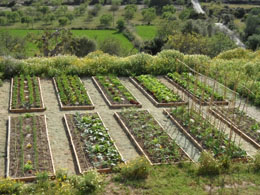Garden beds allow a gardener to control environment and soil conditions, and work with limited spaces without compromising on the décor of the garden. This article highlights some raised garden bed plans.

The whole idea of watching a sapling grow into a beautiful flowering plant, or a plant laded with vegetables can bring immense joy to both; amateur as well as an experienced gardener. But it takes a lot of effort to get there, a lot of back-bending hard work. If one has help, then its probably easy, but for those who have limited help and space, raised garden beds are an easy option. They allow the gardener to decide space and the type of soil he can use.
Steps to be Followed
Raised bed gardening means raising the level of the soil by building a structure using either wooden frames, concrete blocks, bricks, etc, and filling it up with soil. Building a raised bed requires a little understanding of constructing the frame and adding of the soil.
Planning
While deciding upon the type and quantity of the plants to be grown in the raised bed, one should ensure space for growth and distance to be maintained between mature plants. For a combination of taller and shorter plants, grow taller ones in positions where they can't cast a shadow on the other smaller plants. Plants of the same size can be easily grown to make the best use of the limited space. Avoid growing vines with other plants, as they will entangle them and make it difficult for mulching.
Design
The location will depend on what you want to grow. Vegetables and flowering plants need slightly different considerations with regard to soil quality, height, and depth. Shade or full sun-loving plants will also play a role in deciding the location. Start by drawing a rough sketch of your raised bed, as this will help you decide upon the materials required to build one. In most cases, a 3 x 6 feet bed should be ideal for most seasonal plants. Height could be anywhere between 1 to 3 feet tall. Choose your material too - while cedar wood is the most favored, it needs to be changed every few years. If permanency is what you want, then opt for concrete blocks or bricks and mortar.
Construction
Using strings as markers, mark the perimeter of the bed. Clear the soil of all the weeds by digging up the soil a few inches. This will loosen up the soil, and help you ensure a good, leveled base. Dig half feet trenches all around the marked perimeter, and start building. If one is using wooden frames, make sure they are pressure treated with appropriate chemicals. Avoid using chemicals like creosote or pentachlorophenol, as they have a tendency of leaching chemicals into the soil and damaging your plants. Fix the frames (ready-made or sawed by you) along the trenches, and join the ends with building nuts and bolts. If it is a concrete bed you seek, then follow construction method of laying the blocks or bricks upon each other by layering them and cementing them.
Soil
Good soil is essential for healthy growth.are aware of. A raised bed allows us to change the soil conditions drastically, and in certain cases, to suit the requirement of specific plants. If one does not have good garden soil, bring in additional soil to fill the raised bed. This soil should be a combination of light weight, humus-rich soil mixed with organic composite, and some part sand to ensure good drainage. Heavy or clay soil will stagnate water, causing more harm than good to your plants. Controlled humus soil will give the benefits of slow releasing nutrients to the bed, ensuring a steady growth. The fertility of the soil can easily be maintained by adding other organic materials over time.
One of the prominent advantage of raised garden beds is the avoidance of soil compaction. One can never really move around the garden without pressing the soil down. As plants can be easily accessed, weeding, pest control, mulching, and watering can be done without worrying about the back.






 The whole idea of watching a sapling grow into a beautiful flowering plant, or a plant laded with vegetables can bring immense joy to both; amateur as well as an experienced gardener. But it takes a lot of effort to get there, a lot of back-bending hard work. If one has help, then its probably easy, but for those who have limited help and space, raised garden beds are an easy option. They allow the gardener to decide space and the type of soil he can use.
The whole idea of watching a sapling grow into a beautiful flowering plant, or a plant laded with vegetables can bring immense joy to both; amateur as well as an experienced gardener. But it takes a lot of effort to get there, a lot of back-bending hard work. If one has help, then its probably easy, but for those who have limited help and space, raised garden beds are an easy option. They allow the gardener to decide space and the type of soil he can use.